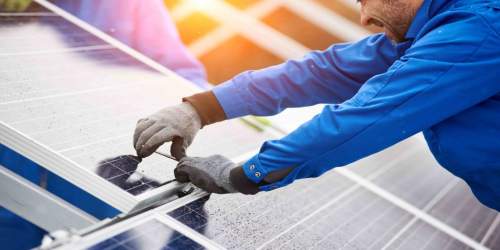Read Time : 4 Minutes
How do Solar Panels Work
Welcome! In the video below you can get an animated and simplified look at how solar panels convert sunlight into usable electricity, for a bit more depth read on.
Solar panels work by harnessing the energy from the sun and converting it into electricity through a process known as the photovoltaic effect.
How do Solar Panels work for your home?
- Photovoltaic Cells: Solar panels are made up of many individual solar cells, which are also called photovoltaic cells. These cells are typically made from semiconductor materials, such as silicon.
- Absorption of Sunlight: When sunlight hits the solar panels, the photons (particles of light) in the sunlight are absorbed by the semiconductor material. The energy from these photons is transferred to the electrons in the semiconductor.
- Generation of Electron-Hole Pairs: As the electrons in the semiconductor absorb energy from the photons, they become energized and move to a higher energy state, leaving behind "holes" in their previous positions. This creates electron-hole pairs within the semiconductor.
- Electric Field Formation: The structure of the solar cell is designed to create an electric field across the semiconductor material. This electric field forces the energized electrons to move in a specific direction, from the n-type (negative) layer to the p-type (positive) layer of the semiconductor.
- Current Generation: As the energized electrons move through an external circuit, they create an electric current. This flow of electrons is what we refer to as electricity. The electric current can be used to power electrical devices or stored in batteries for later use.
- Direct Current (DC): The electricity generated by a single solar cell is in the form of direct current (DC). DC is the type of electricity produced by batteries and is used in many electronic devices. However, most of the electricity used in homes and businesses is alternating current (AC). To make the electricity produced by solar panels compatible with AC-based electrical systems, an inverter is used to convert the DC electricity into AC electricity.
- Wiring and Arrays: Solar panels are typically connected in series or parallel to form arrays, which can generate a higher voltage and power output. These arrays are then connected to the electrical system of a building or grid.
- Grid Connection (if applicable): In grid-tied solar systems, excess electricity generated by the solar panels can be fed back into the electrical grid. This process can allow homeowners or businesses to receive a payment for the excess electricity they generate and send back to the grid through the Smart Expert Guarantee (SEG).
How do Solar Panels Work diagram:

Photovoltaic Cells
Photovoltaics has been around for a good few years now. Back in the late 1950s PV cells were almost exclusively used to power things like satellites. And many of us remember having calculators at school that didn’t need a battery because they were powered by the sun. The desire to harness that energy has been the Holy Grail of renewables for the last 30 to 40 years.
The great thing about solar cells is that they don’t need bright sunshine to work. They just require light and can produce electricity even on a cloudy day – which is great news here in the UK.
There are several types of photovoltaic cell used in solar panels UK. They are made from silicon, an excellent semi-conductor. These different cells vary in the efficiency of their electricity production, their purity and their cost. Put simply, the cells absorb the light from the sun and convert it to electricity. By placing a connection either end of the cell you can then collect that current and use it to power all your energy needs. Find out more about the different types of photovoltaic cells.
COMPARE PRICES FROM LOCAL INSTALLERS
Compare prices from local companies fast & free
Enter your postcode to compare quotes from leading professionals. We promise to keep your information Safe & Secure. Privacy Policy
The Solar Panels
The photovoltaic cells are bunched together into modules that make up a panel. In a typical solar panel, you will have two thin layers of silicon that have been treated in slightly different ways. The top layer, facing the sun, has atoms that are unstable so that when an energy source hits them, electrons fly off. The lower layer has a number of ‘gaps’ in the atoms that are in dire need of an electron or two.
What happens when sunlight hits the top layer is that the unstable electrons get excited and are attracted down to the bottom layer. This movement of electrons causes a current. If you add two metal contacts above and below, you have a circuit and a system that produces electricity.
Types of Solar Panel We are all familiar with the glass style solar panels we see on roofs around town. There are a number of different varieties now available, including ones that look like normal tiles. Find out more about the different types of solar panels on the specific page dedicated to this answer.
Converting the Electricity
How do solar panels work on a house UK? The current created in the solar panels by the excitation of electrons is called direct current or DC current. DC electricity is not suitable for running our household appliances or feeding into the National Grid. To be of any use at all, a conversion to AC electricity or alternating current is necessary. For this you need a box called an inverter. This usually sits outside your panel array, somewhere like the attic. The DC current enters it and emerges as AC and can be fed into your house. More on inverters here.
Efficiency of Solar Panels
If you want to buy solar panels for your home or business then there are a number of considerations to make that will have an effect on the efficiency of electricity production including the location and type of array. Efficiency of the photovoltaic cells: There are different types of cell that produce more or less energy depending on their size, thickness and purity. The purer kind tend to be more efficient and hence more expensive.
A South facing roof: To get the optimum energy production you need a South facing roof. This will ensure the panels catch more of the direct sunshine. That said, you can generally install east to west through south.
Potential shade: Do you have trees surrounding your roof? Then you need to consider how much it will be in shade over the summer months. An oak tree may seem fine in winter when the branches are bare, but when it is in full bloom that may have an adverse effect on the amount of electricity you can produce.
Roof angle: Most installers of solar panels recommend an inclination of between 22 and 75 degrees to get the most out of the sunlight. The ideal angle will also depend where in the UK your house located. For a house in London the ideal roof or solar panel array angle is 51 degrees, while in Aberdeen that is 57. There are also changes throughout the seasons. You may want to consider a solar panel installation that can be adjusted. Adjustable panels will get the optimum amount of sunshine.
Size and number of panels: Of course, you will need to have enough room on your roof to cope with the right number of panels. There will need to be enough to provide all your energy needs. You will want to be able to produce a surplus for selling onto the National Grid. As a rule, higher purity, more expensive photovoltaic cells need less space than cheaper alternatives. It’s a question of getting the right balance between cost and efficiency and the space you must devote to the installation.
How much do Solar Panels Cost?
Now that you know how solar panels work, you may be ready to ask the big question.. How much do solar panels cost?
How do solar panels work with your electricity bill? Three things can happen with the electricity your panels generate during daylight hours.
- It is used at the point of generation within your home or business. Most homes have an idle electrical demand, for things like your fridge, phones, alarms, heating controls etc
- It is sent to your battery for use on demand when your electrical usage is higher than the output of the solar panels. Especially, at night.
- It is sent back to the grid (basically to your neighbours). In this case you may be applicable for the Smart Export Guarantee (SEG). Check with your energy provider for their terms and conditions.
Please check this guide for all the information you need. The infographic below will give you a vague idea, if that's all you're looking for.
Finding the Right Solar Panels for your House
There are several things you must think about when getting solar panels installed. That’s why it’s always a good idea to get some advice from the experts. Check out our database of approved installers who can assess your property and come up with the right solutions for your energy needs.
Find a local installer
Welcome to the biggest directory of UK renewable energy companies







 How Much do Solar Panel Systems Cost in 2024?
How Much do Solar Panel Systems Cost in 2024?







